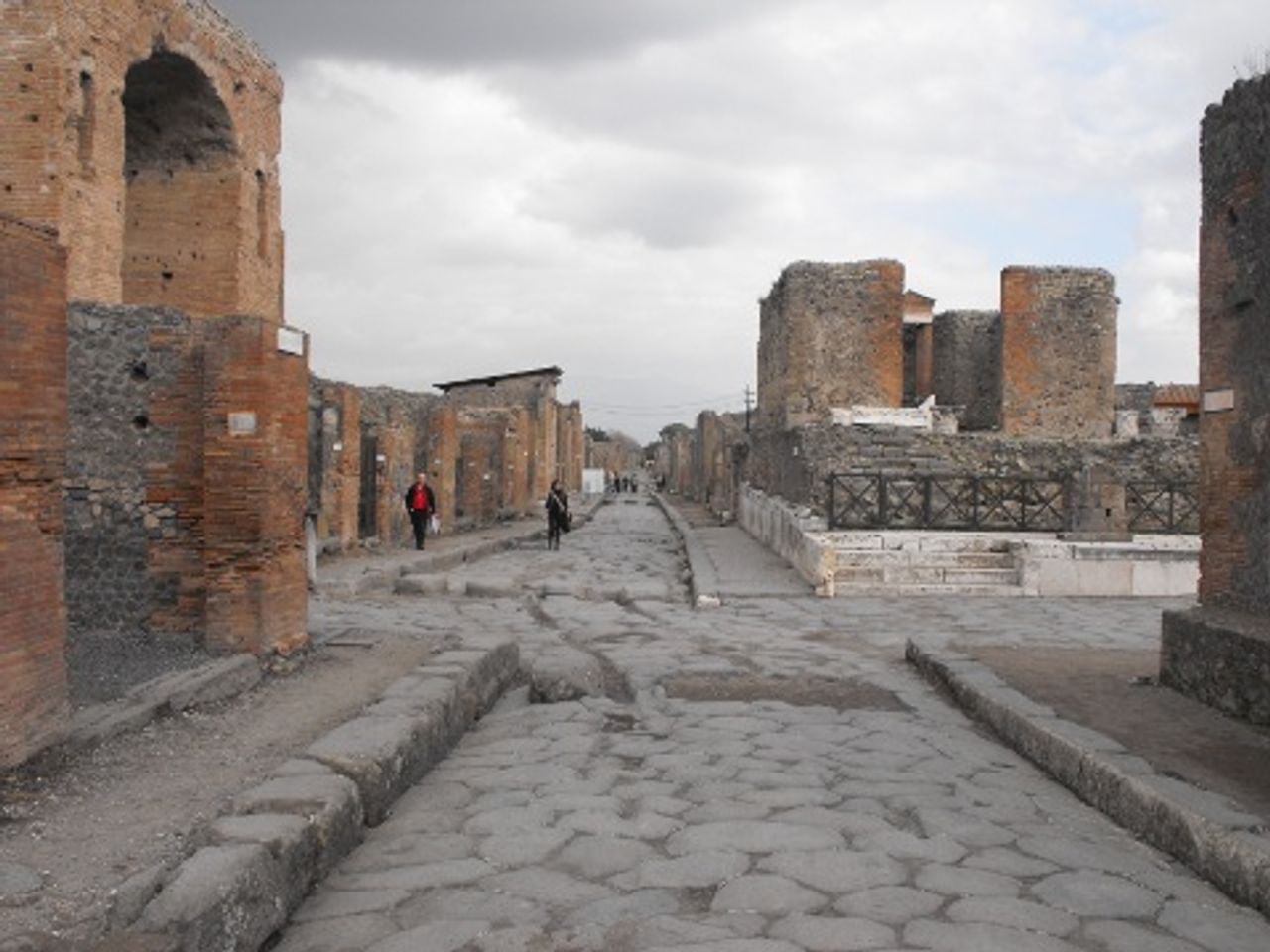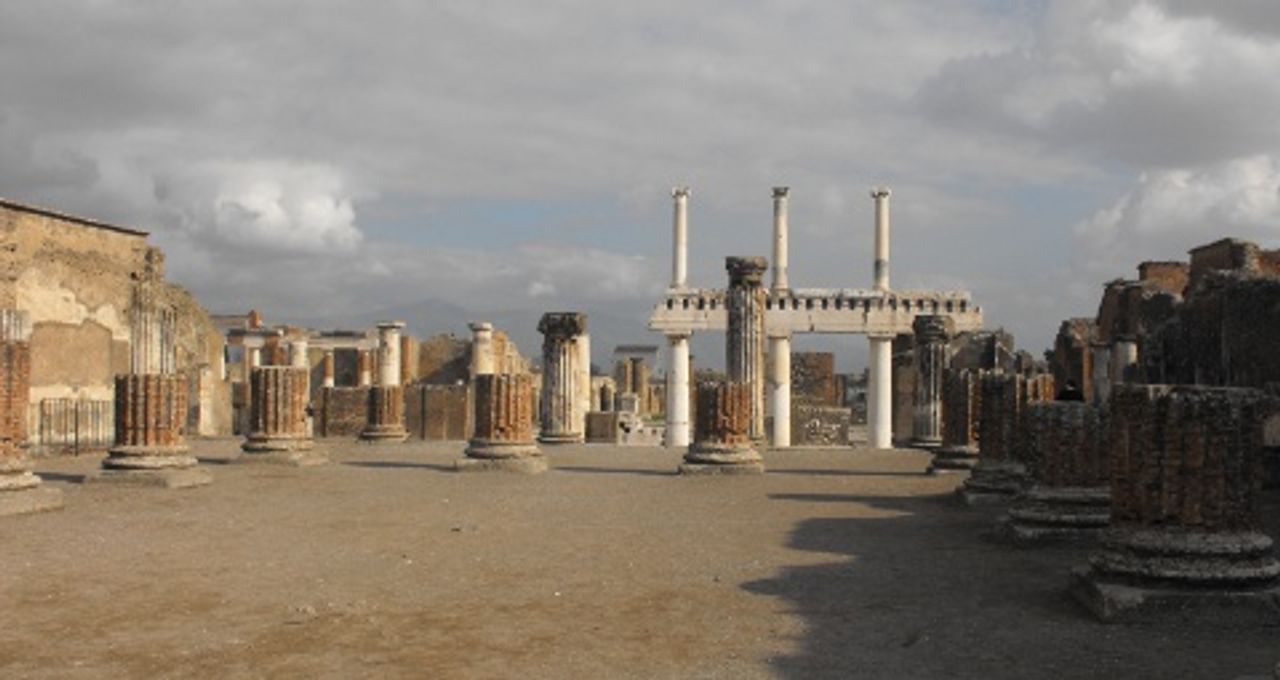Pompeii, south of Naples, is one of the most important archaeological sites in the world, offering a unique glimpse of ancient Roman life. Along with neighbouring locations, the entire town was buried in AD 79 under metres of ash and rock from the eruption of Mt Vesuvius, creating a virtual time capsule. Lost for centuries, Pompeii was discovered and excavated from 1749, opening up a new understanding of the Roman world. However, the future of the site has been placed in great danger. Years of under-funding and over-exploitation have begun to take their toll, leading to widespread degradation and even the collapse of parts of the ruins.
The Pompeii site covers the remains of a town with a population that possibly reached 20,000. It is 163 acres in size, with 109 acres excavated and another third of the town still buried. The level of preservation is unparalleled. Artworks, sculptures and even carbonised papyri scrolls are intact. The layout is complete, allowing archaeologists and visitors to explore the virtually untouched ruins of a 2,000-year-old town. Pompeii has left behind a vast cultural and historical legacy, influencing modern art and film as well as cultural depictions of the Romans. In 1997, the site was placed on the World Heritage List due to its exceptional preservation of the ancient world.
Yet, despite its historical and cultural importance, the town has been allowed to slowly decay. Efforts to protect the site have often been limited in their scope and lacking in adequate funds. Above all, the problem stems from the desire of successive Italian governments and local administrations to exploit Pompeii as a source of revenue. Bureaucratic red tape, poor archaeological methods, improper restoration techniques and natural erosion have been identified as other major concerns. The main danger, however, is the over-exploitation of the town for commercial purposes.
 Pompeii ruins
Pompeii ruinsThe degradation involves fading and damaged frescos and mosaics, which line the floors and walls of the various houses, decaying buildings that in some cases are falling apart and vandalism. Some of the most-at-risk areas have now been closed off to the general public. What is necessary to improve conservation at the site is a matter of debate, but better maintenance, security and restoration work are frequently raised as key issues.
The seriousness of the situation prompted the United Nations Environmental, Scientific and Cultural Organization (UNESCO) and the European Union (EU) to step in last November to help save Pompeii. The EU pledged €105 million, as part of a $1 billion package for heritage sites across southern Italy. But the money, even if finally given in full, will not meet the estimated cost of preserving the site.
UNESCO announced an agreement with the Italian government to assist, but this amounted to little more than providing technical advice. By January, the organisation had shifted its tone from optimism to frustration with the Italian government. Giovanni Puglisi, president of the Italian national commission for UNESCO, told the media: “The funds are there. The work sites have to open. Enough of playing around with bureaucracy.” He further threatened to designate Pompeii an “at risk” site—a designation that could lead to Pompeii’s removal from the World Heritage List unless urgent work proceeded. A de-listing would lower its value as a tourist site.
 Pompeii crossroads
Pompeii crossroadsThough concerns over Pompeii’s future have been a reoccurring theme, significant warnings were sounded in 1996 when Pompeii was placed on the World Monument’s Fund as a heritage site at serious risk of degradation. The Italian government of Romano Prodi responded in 1997 by declaring that all money earned from tourist sales would be placed at the disposal of Pompeii management and reinvested in the site.
More than 2.5 million people pass through Pompeii’s gates every year. It is not uncommon for visitors to accidentally damage artworks by touching them or for more malicious individuals to take small souvenirs or leave graffiti. The number of custodians is insufficient to properly monitor such a vast area crowded with people, even though ticket sales generate over €20 million annually.
Estimates in 2010 put the amount needed to rescue Pompeii at €260 million, which is double the EU pledge. A large percentage of the ticket money was not invested in preservation, but went into facilities to boost visitor numbers, including more ticket booths, safety features, advertising campaigns, live performances in a restored amphitheatre and elaborate multimedia simulations in restored houses.
Some politicians have proposed curtailing numbers, but only as a means of encouraging other forms of commercial exploitation. In 2008, the regional heritage councillor for Campania, Claudio Velardi, a former political ally of Prime Minister Massimo D’Alema, told the media that he would support fewer tourists, in order to allow Pompeii to be used by companies such as Google or Microsoft for private events. He mentioned the possibility of opening Pompeii to film studios, such as Pixar or Warner Bros, to shoot movies on the site for an “astronomical fee.”
“If we cap the number of visitors it will be easier to allow businessmen within the ruins to make money and hold events without being hampered by cultural fuddy-duddies,” Velardi said.
Though Velardi’s proposals were not accepted, Pompeii is already open to private functions. The palestra in Pompeii and the amphitheatre, in particular, have been used for private performances or pre-election dinners for local politicians. Other companies have provided funds for projects that offer branding opportunities and local recognition.
Private investment has been promoted as a means of supplementing or replacing the meagre financial support received from the Italian government. Even before the euro crisis, the Italian Culture Ministry, which oversees the management of Pompeii, had yearly cuts to its budget, which presently makes up only 0.18 percent of government spending. Over the past three years, the ministry’s funding has been slashed from €603 million to €340 million and is likely to be cut further amid the Italian debt crisis.
Herculaneum, a similar but smaller site near Pompeii, had received some private funding, including from the California-based Packard Humanities Institute which donated €15 million for preservation projects. David Packard, the institute’s founder, had a personal interest in Herculaneum, unlike the corporations seeking access to Pompeii.
 Looking towards the Pompeii forum
Looking towards the Pompeii forumThe collapse of Pompeii’s School of the Gladiators in November 2010 encouraged more open calls for privatisation of the site. Initially, there was a proposal to offer Pompeii for advertising and branding in return for funds to help maintain the town. The Italian business newspaper Il Sole 24 Ore and the Wall Street Journal have backed such suggestions for some time.
Other obvious signs of decay followed the disintegration of the Gladiator School, which contained important frescos depicting martial scenes. A section of wall near the House of the Moralist fell a few weeks later. Responding to criticism, Culture Minister Sandro Bondi told Corriere della Sera there had been 16 collapses at Pompeii between September 2003 and February 2010. He later resigned over accusations that he was mismanaging the site.
Pompeii has had no organised program of overall maintenance for almost half a century. By late 2011, there were just five designated maintenance workers for the entire town. Bureaucratic delays and disputes have been blamed, but the lack of funding remains the main issue.
The Italian National Association of Architects recently warned: “A year after the collapse of the House of the Gladiators nothing concrete has been done... There is a continued lack of ordinary maintenance, which is the only way to save the site. Our fear is that the coming months will see ever more frequent and serious incidents.”
No aspect of human life and culture is immune from the insidious operations of the profit system. Rather than being preserving for future generations, this irreplaceable archaeological site is, under the impact of governmental neglect and commercial exploitation, confronting accelerating decay and degradation.
